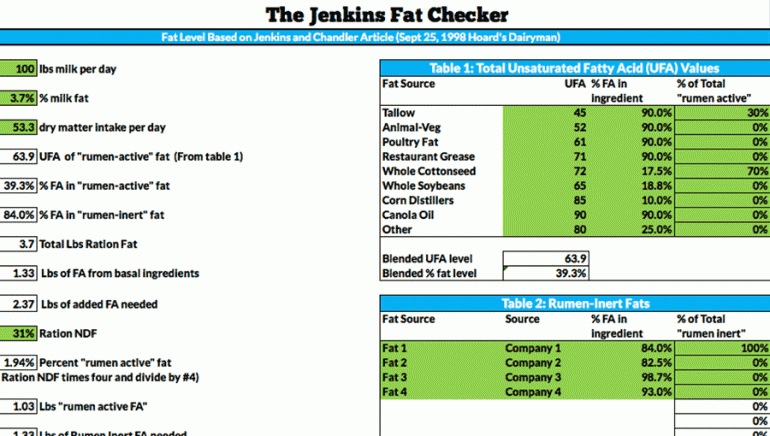
Fat Feeding Strategies to Maximize Returns – Dr. Tom Jenkins
November 16, 2012
Dr. Tom Jenkins of Clemson University discusses how to decide on the proper amount of fat to feed, decoding oversimplified fat feeding recommendations and avoiding rumen digestibility problems to maximize your returns from feeding fat. The Fatty Acid Forum is an ongoing learning platform sponsored by Virtus Nutrition that enables dairy nutrition professionals to have direct access to leading researchers on fatty acid nutrition and physiology.
The Jenkins Fat Checker
As featured in this webinar
The Jenkins Fat Checker tool is intended to describe practical limits of rumen-active and total added fat that gives an acceptable milk response in situations where you are:
- Considering fat for the first time
- Changing sources of rumen-active fat, or
- The composition of your present fat source has changed dramatically.
Download the Jenkins Fat Checker (Excel)
Want to save this webinar for offline viewing?
Download Webinar #3 Presentation (PDF)
Fat Feeding Strategies to Maximize Returns Q&A
- How do cotton seed & other oil seeds apply in this situation?We want to give credit to the fact that there may be some rumen protection of the fat in oil seeds by the nature of the hard outer seed coat, so we don’t want to just apply it just to these calculations and let it got at that. Yet when I look at the a lot of the data that is published over the years there are many instances when oil seeds can cause damage in the rumen and this is surely due to the processing of it and rumen processing but I think also to mastication and destruction of that seed coat or rumination or even softening during the rumen fermentation process. So I tend to err on the conservative side and not give 100% bypass value to cotton seed & other oils seeds but try to maybe put it down to a quarter to a third bypass value for cotton seed so I’m giving a little bit of credit to that hard outer seed coat but not depending on it to be completely available all the time in all instances. So I’ll run it through these calculations and then I’ll raise the amount of cotton seed that I’m going to feed by 20, 25% or may be even 30% and allow for some advantage in that situation.
- What are the consequences of feeding more than the calculations recommend?The calculations here are designed to hit that midpoint of what I call the phase II area and try to keep us in a safe mode. So going more than that increases the risk that you may get into what I refer to as phase III and now you begin to see milk fat depression problems and maybe you’ll see impact problems and lower milk yield along with that all those things can happen by feeding too much fat. Another thing to consider is where are you in that phase II? Are you at the lower end or are you at the upper end? So you might be able to feed more fat than what these calculations are saying, and you say well there is no detrimental effect from it but I might argue that all you are doing is pushing yourself from the lower end of phase 2 to the upper end where you are not gaining any more animal response or production benefits from it. The calculations were designed to optimize or maximize the animal response per unit of added fat. It’s trying to get you to the safe level to give you the best return on your investment and not try to beat the competition to see who can feed the most amount of fat that they can feed but more can geared towards trying to optimize that return.
- Are there exception scenarios that you commonly run into in making these calculations that make them irrelevant or less applicable?I’m depending on our attendees to try some of this and to help us out and let us know where some of the exceptions are. I’ve had a number of beta testers of this spreadsheet and the feedback I’ve been getting so far tells me that they run through the calculations and generally speaking have had things work out quite favorably. I don’t have any instances that have come to my attention where this has fell through or been a failure but we certainly hope that those of you that are listening might want to get your hands on this spreadsheet and give it a try. If you are feeding fat already, try your fat source and this spreadsheet and see how close it comes to what you are doing. I want to give a lot of credit to your experience. This spreadsheet is not going to trump your experience in feeding fat. Your experience comes first. But see how this spreadsheet lines up with what you do know to be the true animal response and give us some feedback on that. So far I’m not aware of any instances where it’s going to give you answers that are going to be too dangerous or too unsafe.That’s a good challenge to the group and that will help as you move forward and provide additional content in these fatty acid forums. I’m sure he will like to hear from all and your experience in using that spreadsheet and what you are doing out on the dairy.

Dr. Tom Jenkins
Professor, Department of Animal & Veterinary Sciences
Clemson University
See all sessions with Dr. Jenkins
Tags: Dr. Tom Jenkins
© 2024 Virtus Nutrition, LLC







Leave a Comment